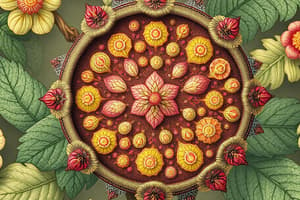Podcast
Questions and Answers
Which type of glycoside is formed through a condensation reaction involving oxygen?
Which type of glycoside is formed through a condensation reaction involving oxygen?
- Sulphur glycosides
- Cyanophore glycosides
- Carbon glycosides
- Ether linkage glycosides (correct)
What process leads to the formation of cyanophore glycosides?
What process leads to the formation of cyanophore glycosides?
- Hydrolysis of sugar
- Addition of carbon
- Loss of nitrogen
- Loss of water (correct)
Which of the following is NOT a type of glycoside mentioned?
Which of the following is NOT a type of glycoside mentioned?
- Cyanophore glycosides
- Nitrogen glycosides (correct)
- Carbon glycosides
- Ether glycosides
What is the key characteristic of sulphur glycosides?
What is the key characteristic of sulphur glycosides?
In the context of glycosides, what does the 'C-' suffix indicate?
In the context of glycosides, what does the 'C-' suffix indicate?
What effect do cardiac glycosides have on renal circulation?
What effect do cardiac glycosides have on renal circulation?
Which is an example of a cardiac glycoside mentioned?
Which is an example of a cardiac glycoside mentioned?
Which of the following is not a characteristic of cardiac glycosides?
Which of the following is not a characteristic of cardiac glycosides?
What method is used for the identification of cardiac glycosides?
What method is used for the identification of cardiac glycosides?
Which statement about diuretic effects of cardiac glycosides is correct?
Which statement about diuretic effects of cardiac glycosides is correct?
What are anthocyanin glycosides primarily known for?
What are anthocyanin glycosides primarily known for?
Which group of compounds are anthocyanin glycosides structurally related to?
Which group of compounds are anthocyanin glycosides structurally related to?
Which glycoside is derived from Black Mustard seeds?
Which glycoside is derived from Black Mustard seeds?
Which of the following is NOT a characteristic of anthocyanin glycosides?
Which of the following is NOT a characteristic of anthocyanin glycosides?
What type of gas is associated with Sinigrin from Black Mustard seeds?
What type of gas is associated with Sinigrin from Black Mustard seeds?
What role do anthocyanin glycosides play in plants?
What role do anthocyanin glycosides play in plants?
Which of the following is a characteristic of Sinalbin derived from white Mustard seeds?
Which of the following is a characteristic of Sinalbin derived from white Mustard seeds?
Which statement is true about the color of anthocyanin glycosides?
Which statement is true about the color of anthocyanin glycosides?
What is the chemical structure notation for thioglycosides?
What is the chemical structure notation for thioglycosides?
Which of these compounds is associated specifically with sulpher glycosides?
Which of these compounds is associated specifically with sulpher glycosides?
What color precipitate does Mayer's reagent produce with most alkaloids?
What color precipitate does Mayer's reagent produce with most alkaloids?
Which alkaloid does not produce a precipitate when treated with Mayer's reagent?
Which alkaloid does not produce a precipitate when treated with Mayer's reagent?
What is the color produced by Dragendorff's reagent when it reacts with alkaloids?
What is the color produced by Dragendorff's reagent when it reacts with alkaloids?
Which reagent is commonly used to identify alkaloids aside from Mayer's reagent?
Which reagent is commonly used to identify alkaloids aside from Mayer's reagent?
What effect do drugs containing saponins generally have on the mucous membranes?
What effect do drugs containing saponins generally have on the mucous membranes?
Mayer's reagent is primarily used to test for which class of compounds?
Mayer's reagent is primarily used to test for which class of compounds?
Which of the following uses is NOT associated with saponins?
Which of the following uses is NOT associated with saponins?
What property of saponins makes them effective in cleaning applications?
What property of saponins makes them effective in cleaning applications?
Which part of the body is primarily affected by the sternutatory nature of saponins?
Which part of the body is primarily affected by the sternutatory nature of saponins?
In addition to cleaning, what is another major application of saponins?
In addition to cleaning, what is another major application of saponins?
Flashcards
Glycosidic Bond Formation
Glycosidic Bond Formation
Forming a glycosidic bond by removing water and linking a sugar molecule to another molecule.
Oxygen Glycosidic Bond
Oxygen Glycosidic Bond
A type of glycosidic bond where oxygen acts as the bridge between the sugar and another molecule.
Carbon Glycosidic Bond
Carbon Glycosidic Bond
A type of glycosidic bond where carbon acts as the bridge between the sugar and another molecule.
Sulfur Glycosidic Bond
Sulfur Glycosidic Bond
Signup and view all the flashcards
Cyanophore Glycosidic Bond
Cyanophore Glycosidic Bond
Signup and view all the flashcards
Anthocyanin Glycosides
Anthocyanin Glycosides
Signup and view all the flashcards
Flavonoids
Flavonoids
Signup and view all the flashcards
Relation between Anthocyanin Glycosides and Flavonoids
Relation between Anthocyanin Glycosides and Flavonoids
Signup and view all the flashcards
Function of Anthocyanin Glycosides in Flowers
Function of Anthocyanin Glycosides in Flowers
Signup and view all the flashcards
Role of Anthocyanin Glycosides in Flower Color Intensity
Role of Anthocyanin Glycosides in Flower Color Intensity
Signup and view all the flashcards
Cardiac glycosides' positive inotropic effect
Cardiac glycosides' positive inotropic effect
Signup and view all the flashcards
Cardiac glycosides negative chronotropic effect
Cardiac glycosides negative chronotropic effect
Signup and view all the flashcards
Cardiac glycosides' negative dromotropic effect
Cardiac glycosides' negative dromotropic effect
Signup and view all the flashcards
Diuretic effect of cardiac glycosides
Diuretic effect of cardiac glycosides
Signup and view all the flashcards
Digitoxose
Digitoxose
Signup and view all the flashcards
Saponin Effect on Mucous Membranes
Saponin Effect on Mucous Membranes
Signup and view all the flashcards
Saponins as Cleaning Agents
Saponins as Cleaning Agents
Signup and view all the flashcards
Emulsifying Power of Saponins
Emulsifying Power of Saponins
Signup and view all the flashcards
Mayer's Reagent
Mayer's Reagent
Signup and view all the flashcards
Mayer's Reagent composition
Mayer's Reagent composition
Signup and view all the flashcards
Dragendorff's Reagent
Dragendorff's Reagent
Signup and view all the flashcards
Dragendorff's precipitate
Dragendorff's precipitate
Signup and view all the flashcards
Alkaloids
Alkaloids
Signup and view all the flashcards
Thioglycosides
Thioglycosides
Signup and view all the flashcards
Sinigrin
Sinigrin
Signup and view all the flashcards
Sinalbin
Sinalbin
Signup and view all the flashcards
Thiocyanate (S-C=N)
Thiocyanate (S-C=N)
Signup and view all the flashcards
Sulfur Glycosides
Sulfur Glycosides
Signup and view all the flashcards
Study Notes
Lecture 5: Pharmacognosy I (PHCG 111)
- Secondary Plant Metabolites (Active Constituents)
- Secondary metabolites act as protective agents, waste products of metabolism, and aid in producer survival.
- They are energy producers and physiologically active.
- These metabolites are various organic compounds.
Carbohydrates and Related Compounds
- Compounds composed of carbon, hydrogen, and oxygen as polyhydroxy aldehydes or ketone alcohols, such as sucrose, lactose, starch, gums, mucilage, and pectin.
- Gums
- Polysaccharides or salts of Polysaccharides.
- Produced in higher plants as protective agents after injury.
- On hydrolysis, gums yield arabinose, galactose, glucose, mannose, and various uronic acids (which can form salts with Ca, Mg, and other cations).
- Examples: gum acacia and gum tragacanth.
Mucilage
- Polysaccharide complexes.
- Insoluble in alcohol, forming viscous, non-adhesive colloidal solutions in water, which do not form jelly.
- Types include:
- Pectose type (red color with ruthenium red, eg. Senna, Buchu, and Henna leaves)
- Callose type (red color with corallin soda, eg. squill)
- Neutral type (blue color with methylene blue, eg. Foenugreek)
Pectin
- Purified carbohydrate (CHO) extracted from dilute acid extracts of the inner rind of citrus fruits or apple pomace.
- Soluble in 20 parts water, forming a stiff gel.
- Used as a protective and suspending agent, and an ingredient in antidiarrheal preparations.
Glycosides
- Non-reducing organic compounds that yield one or more sugars upon hydrolysis using dilute acids, alkalis, or enzymes.
- The non-sugar part is called the aglycone (genin), and the sugar component is the glycone.
- Chemically, glycosides are considered sugar ethers, formed by water loss and linkage formation (O-, C-, S-, CN-).
- Glycosides are generally soluble in water and hydro-alcoholic solvents due to the hydrophilic nature of the sugar. The higher the sugar content, the lower the solubility in organic solvents. The aglycone is more soluble in organic solvent.
Types of Glycosides
- A. Phenolic Glycosides
- i. Simple Phenolic Glycosides: e.g., Arbutin (a hydroquinone glycoside) from Uva ursi leaves, used in urethritis and cystitis.
- ii. Flavonoid Glycosides: Largest group of naturally occurring phenols occurring in plants as free aglycones, or as glycosides. Examples: Diosmin (Buchu), Hesperidin (Citrus species). They are yellow compounds, dissolving in aqueous alkali and giving a canary-yellow color.
- iii. Anthocyanin Glycosides: Structurally related to flavonoids, producing pigment in colored flower petals. Their color changes (red-violet to blue) are pH-dependent (e.g., Karkadeh).
- iv. Anthraquinones Glycosides: Pharmacologically active constituents in laxatives and purgatives (e.g., Senna). Give positive Borntrager's and modified Borntrager's tests.
- B. Alcoholic Glycosides (Cardiac Glycosides):
- Exert powerful action on cardiac muscles.
- Small amounts can stimulate a diseased heart, but large doses cause death.
- Used to increase cardiac muscle tone, excitability, and contractility, and as diuretics due to increased renal circulation.
- Example: Digitalis.
- SAR (Structure-Activity Relationship) for Cardiac Glycosides: Steroidal nucleus and lactone ring (5- or 6-membered) with a deoxy sugar (e.g. Digitoxose). Detection of cardiac glycosides: chemical tests for steroidal nucleus and deoxy sugars and unique lactone rings.
- ii. Saponin Glycosides:
- Characterized by foaming in water, causing red blood cell lysis (hemolysis), sternutatory effects, and irritation of mucous membranes (eyes/nose).
- Used as emulsifiers in industrial cleaning and for certain resins, fats, and fixed oils.
- C. Cyanophore Glycosides:
- Yield HCN upon hydrolysis.
- Limited use in pharmacy due to HCN's toxicity.
- Detected by reaction with sodium picrate paper (Grignard Reaction).
- D. Thioglycosides:
- Contain thiocyanate (S-C≡N) or sulphur.
- Examples: Sinigrin (from black mustard seeds, mustard irritant gas) and Sinalbin (from white mustard seeds, non-volatile).
Tannins
- Large group of complex substances, non-crystalline, with a sharp astringent taste.
- Form colloidal solutions in water.
- Precipitate proteins and alkaloids.
- Uses: Astringents, hemostatics, protective coating for burns, antidotes for metal and alkaloid poisoning, tanning of leather, and ink production.
- Types:
- Hydrolysable Tannins: Hydrolyzed by acids or enzymes (e.g., tannase), composed of phenolic acids (gallic acid), giving a blue-black color with FeCl3 and no precipitate with bromine water. Examples: clove and galls.
- Condensed Tannins: Not readily hydrolyzed, do not contain sugar moieties, yield catechins on hydrolysis, green color with FeCl3, and precipitate with bromine water. Examples: tea and henna leaves.
Alkaloids
- Basic nitrogenous compounds of biological origin.
- Physiologically active.
- Not all nitrogen-containing compounds are alkaloids.
- Generally, alkaloidal bases are insoluble in water but soluble in organic solvents. Alkaloidal salts are soluble in water or sparingly soluble in organic solvents.
- Detection:
- Alkaloidal precipitants – e.g. Mayer's reagent (potassium mercuric iodide solution) giving a creamy white precipitate with most alkaloids, except for caffeine.
- Alkaloidal color reagents – e.g. Dragendorff's reagent gives an orange color.
5-Oils
- Volatile Oils (Essential Oils):
- Mix of hydrocarbons (mostly terpenes) and oxygenated compounds (e.g., buchu leaves, lavender flowers)
- Volatile, steam-distilled.
- Used as flavoring, in perfumery, and as spices, antiseptics, and carminatives.
- Do not leave a permanent stain on filter paper
- On standing, they become more resinous.
- Fixed Oils:
- Triglycerides of fatty acids (e.g., linseed seed).
- Nonvolatile.
- Saponifiable
- Leaves a permanent stain on filter paper
- On standing, they become rancid.
- Used in food and paint industries.
Studying That Suits You
Use AI to generate personalized quizzes and flashcards to suit your learning preferences.




